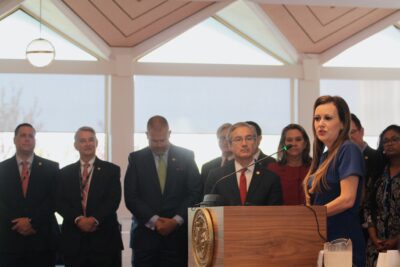
|
|
The short session of the N.C. General Assembly convened on April 24, amidst a 2024 election cycle that is already heating up. How to be an effective advocate in these polarized, politicized times is more important than ever.
“The current education policy landscape is marked by a departure from long-standing bipartisan traditions, spurred by the challenges of recent national and global events,” says a report entitled “Crossing the Partisan Divide in Education Policy,” released by the Aspen Institute in March 2024.
“The COVID-19 pandemic not only disrupted educational norms but also brought to light significant inequities within the system, leading to increased scrutiny and political pressures on schools and educators. The racial and social awakenings of 2020 have further complicated the educational context, pushing the sector to a crossroads where every aspect of school life is subject to intense debate and political activism,” continues the report.
The report is intended to serve as a beacon of hope given the current political landscape, finding — and citing the example of myFutureNC in North Carolina — that “there is still significant potential for achieving cross-partisan successes in education policy.”
What’s the difference between bipartisan and cross-partisan?
The report says, “bipartisanship is defined as the traditional collaboration between the two major political parties, symbolizing commendable compromise and collective victory.”
It notes that “the current political climate often interprets bipartisanship as a capitulation to opposing views, diminishing its value for some.”
Instead, at the root of policy wins in the education space in red states and blue states, the report finds cross-partisan approaches are working.
Cross-partisan is defined by the report as “a contemporary understanding of political collaboration that transcends traditional partisan boundaries, emphasizing support from diverse political spheres, often stemming from varied motivations.”
How to advocate using cross-partisan strategies
Successful cross-partisan education policy initiatives, the report finds, share five key elements:
- Challenges and solutions must be easy to communicate and appeal to a broad base,
- Solutions are responsive to local context and garner local support,
- Parents, teachers, the business community, or politicians in higher office are willing to provide political cover for policymakers,
- Both sides can walk away claiming a win — even if each side’s “win” is different, and
- Using the media as an accelerant.

The report says the following factors can significantly influence outcomes:
Understanding the political landscape | A thorough knowledge of the political environment is essential.
Managing expectations | Recognize the limitations and possibilities within the current political framework.
Addressing frontline concerns | Consider how teachers and school employees will be supported through the policy change.
Focusing on inclusion and expansion | Policies should aim to expand opportunities rather than limit them.
Where cross-partisan strategies make a difference in North Carolina
Despite the headlines — which often focus on policy changes where there isn’t cross-partisan support, including the adequacy of funding — most legislation passed in a given session continues to have support across party lines and other lines of difference. You can see that if you look through the summaries of all of the education legislation that passed last session.
For example, there continues to be broad support for particular education strategies and initiatives:
- The science of reading, including the Excellent Public Schools Act of 2021, which was instrumental in rapidly getting the science of reading into classrooms across North Carolina. See all of EdNC’s literacy coverage here.
- myFutureNC’s alignment of policy to the state’s attainment goal. Here are their policy priorities for 2024.
- NC Ed Corp’s high-dosage tutoring.
- Spark NC’s innovative approach to how to do school, which Sen. Michael Lee, R-New Hanover, has championed and recently won first prize for impact in the 2024 Education Innovation Showcase at the ASU+GSV Summit.
- Supplemental funds for teacher compensation in economically distressed counties and school districts.
- Advanced teaching roles.
- NC Teaching Fellows, which has 462 award recipients for the 2024-25 academic year.
- Bringing improvement science to classrooms and schools through Schools That Lead.
There are more. Please let us know other strategies and initiatives that you think have cross-partisan support.
In the short session, cross-partisan strategies on the expansion of school choice could include:
- Transparency | If there is going to be additional funding for vouchers, then advocates could request transparency on the number of students receiving offers for 2024-25 that are already in private school.
- Data in real time to optimize planning by public schools | The N.C. State Educational Assistance Authority (NCSEAA) is collecting each applicant’s county of residence. Notifications of the number of offers extended by county in real time would be helpful to districts and charters in master scheduling and budget planning. Currently, data on Opportunity Scholarships does not have to be reported by NCSEAA to the N.C. Department of Public Instruction until Oct. 15 (search the budget bill for “Opportunity Scholarship Financial Impact Report/Reinvestment in Public Schools” to see the provision), and it is not clear when districts and charters would receive the data.
- The delta provision | Starting in the 2025-26 school year, the budget said “it is the intent of the General Assembly to reinvest in the public schools any savings realized by the State each year” when a student accepts a scholarship “that is less than 100% of the average State per pupil allocation for average daily membership for a student in a public school unit.” More information is needed on where this fund will be held and how it will be managed and dispersed.
- A swirl provision instead of a hold harmless | Legislators have made it clear that they are not interested in a hold harmless for districts and charters losing students. But would legislators support a swirl provision, where money follow students back into public schools and charters if and when they come back during the school year?
Other examples of policy wins using these strategies, according to the report
The report cites the following as other examples of wins a cross-partisan approach: career and technical education (CTE) advancements, teacher recruitment and retention, and student wellness and engagement.
It includes school choice in that list, finding that in some red states the expansion of school choice has been coupled with teacher pay raises.
North Carolina is not leading the pack when it comes to apprenticeships for teachers, another win identified in the report. According to the National Center for Grow Your Own, North Carolina is one of just 13 states not in the network of states with nationally registered apprenticeships. N.C. A&T University and Western Carolina University are our only educator preparation programs in the EPP network. And none of our 115 districts are in the district network.
The report also lifts up the interstate teacher mobility compact. The Council of State Governments (CSG) partnered with the Department of Defense (DoD) and the National Association of State Directors of Teacher Education and Certification (NASDTEC) to support the mobility of licensed teachers through the development of a new interstate compact. “This compact will create reciprocity among participant states, and reduce barriers to license portability and employment,” says the website. There is model legislation, and this map shows which states have pending and enacted legislation.
Pushing forward on issues that have been politicized, like equity
Michael Petrilli, the president of the Thomas B. Fordham Institute, is acknowledged in the Aspen report for his partnership and guidance. Petrilli kicked off 2024 with his own series of articles on “doing educational equity right”– he intends the double meaning.
The series stems from his leadership with The Building Bridges Initiative, which brought together a diverse group of leaders from left, right, and center and issued a report entitled, “A Generation at Risk” in September 2023.
That report finds: “We cannot be a great nation if we don’t do right by our young people. And we are not doing nearly enough, especially for students from marginalized communities.”
Petrilli’s series on “doing educational equity right” has covered school finance, student discipline, advanced education, school closures, homework, grading, and effective teachers to date.
His goal is to “identify specific education policies and practices that embrace a version of ‘equity’ that can garner broad support across the ideological spectrum and benefit the greatest number of students.”
Petrilli’s work comes at a time in North Carolina when the UNC System is set to repeal its DEI policy, and Sen. Phil Berger, R-Rockingham said, “There are examples of DEI — what I would consider overreach — in other parts of state government or other parts, whether the school systems or otherwise,” according to the News & Observer.
Whether you agree with Petrilli or not, his “doing educational equity right” series offers an example of using the cross-partisan approach to push forward on an issue that matters and needs to be talked about out loud.
Continue to center students
The needs of students, the report notes, don’t go away when politics are less balanced and more divisive.
“Education policy advocates,” it says, “must vigilantly guard against losing focus on the underlying challenges affecting the well-being and future of our children and communities.”




